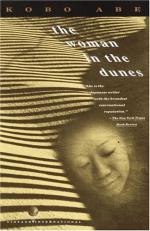|
This section contains 6,656 words (approx. 23 pages at 300 words per page) |

|
SOURCE: Dissanayake, Wimal. “Self, Place, and Body in The Woman in the Dunes: A Comparative Study of the Novel and the Film.” In Literary Relations, East and West: Selected Essays, edited by Jean Toyama and Nobuko Ochner, pp. 41-54. Manoa, Hawaii: University of Hawaii, 1990.
In the following essay, Dissanayake lists the reasons for the success of the cinematic adaptation of Abé's novel The Woman in the Dunes.
The change in the sand corresponded to a change in himself. Perhaps, along with the water in the sand, he had found a new self.1
—The Woman in the Dunes
The novel and the film are two of the most powerful media of symbolic communication in the modern world, and the relationship between them is as complex as it is fascinating. There appears to be an almost inverse relationship between the literary worth of a novel and the artistic worth...
|
This section contains 6,656 words (approx. 23 pages at 300 words per page) |

|


